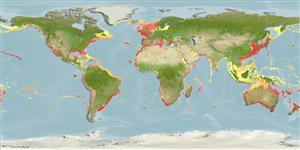Common names from other countries
>
Syngnathiformes (Pipefishes and seahorses) >
Centriscidae (Snipefishes and shrimpfishes) > Macroramphosinae
Etymology: Macroramphosus: Greek, makros = great + Greek, rhamphos = beak, bill (Ref. 45335).
More on author: Linnaeus.
Environment: milieu / climate zone / depth range / distribution range
Ecología
marino demersal; rango de profundidad 25 - 600 m (Ref. 9563), usually 50 - 350 m (Ref. 47377). Subtropical; 66°N - 43°S, 180°W - 180°E
Western Atlantic: Gulf of Maine to Argentina (Ref. 37039). Eastern Atlantic and Mediterranean. Indo-West Pacific. Mainly in temperate latitudes between 20° and 40°N. Presence in Somalia to be confirmed (Ref. 30573).
Tamaño / Peso / Age
Maturity: Lm ? range ? - ? cm
Max length : 20.0 cm TL macho / no sexado; (Ref. 4508); common length : 12.0 cm TL macho / no sexado; (Ref. 4508)
Short description
Claves de identificación | Morfología | Morfometría
Espinas dorsales (total) : 6 - 8; Radios blandos dorsales (total) : 11 - 13; Espinas anales: 0; Radios blandos anales: 18 - 20; Vértebra: 24. Reddish pink in color, silvery below (Ref. 5382). Body compressed, without scales. Mouth is placed at the end of the long tubular snout (Ref. 35388). Snout length (6.1cm), length of second dorsal spine (LDS 3.9 cm) (Ref. 39875).
Found between the seabed and midwater on the lower continental shelf, over sand. Juveniles found in oceanic surface waters (Ref. 2683); adults normally live close to the bottom (normally in 50-350 m depth (Ref. 47377)). Gregarious. Juveniles feed mainly on pelagic invertebrates, mainly copepods, while adults feed on bottom invertebrates (Ref. 6732). Seems to be sympatric with Macroramphosus gracilis (Lowe, 1839) all around the world (Ref. 89357).
Life cycle and mating behavior
Maturities | Reproducción | Spawnings | Egg(s) | Fecundities | Larva
Ehrich, S., 1990. Macroramphosidae. p. 656-657. In J.C. Quero, J.C. Hureau, C. Karrer, A. Post and L. Saldanha (eds.) Check-list of the fishes of the eastern tropical Atlantic (CLOFETA). JNICT, Lisbon; SEI, Paris; and UNESCO, Paris. Vol. 2. (Ref. 4508)
IUCN Red List Status (Ref. 130435)
CITES (Ref. 128078)
Not Evaluated
Threat to humans
Harmless
Human uses
Pesquerías: comercial; Acuario: Acuarios públicos
Herramientas
Special reports
Download XML
Fuentes de Internet
Estimates based on models
Preferred temperature (Ref.
115969): 6.5 - 22.7, mean 13.6 (based on 2092 cells).
Phylogenetic diversity index (Ref.
82804): PD
50 = 0.7502 [Uniqueness, from 0.5 = low to 2.0 = high].
Bayesian length-weight: a=0.00891 (0.00668 - 0.01189), b=2.83 (2.75 - 2.91), in cm Total Length, based on LWR estimates for this species (Ref.
93245).
Nivel trófico (Ref.
69278): 3.5 ±0.40 se; based on food items.
Resiliencia (Ref.
120179): Medio, población duplicada en un tiempo mínimo de 1.4-4.4 años (K=0.36-0.46; tmax=6).
Fishing Vulnerability (Ref.
59153): Low to moderate vulnerability (27 of 100).
